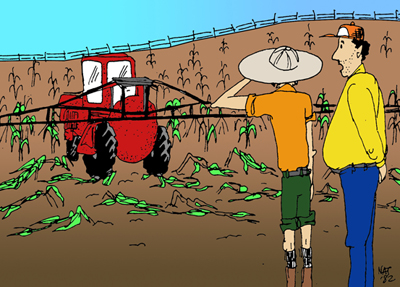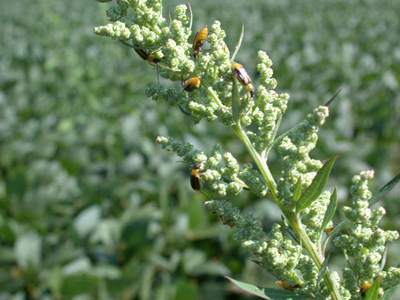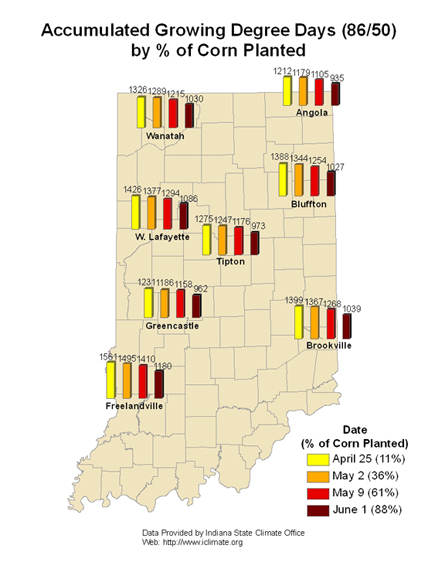Pest & Crop Newsletter, Entomology Extension, Purdue University
- Lower Rootworm Beetle Numbers Now, Lower Larval Risk Later
- Soybean Aphid Update
- Black Light Trap Catch Reports
Lower Rootworm Beetle Numbers, now, Lower Larval Risk Later – (John Obermeyer and Larry Bledsoe)
- Statewide, rootworm and Japanese beetle numbers are lower.
- Cool, wet spring not only hurt the crop but insects as well.
- Less beetles will lay fewer eggs and reduce the impact onnext year’s corn.
- Pollen sources, e.g., weeds or late-corn, may be a “trap” crop for beetles.
- Indiscriminate tank-mixing of insecticide with fungicides applications not a good idea.
Reports of low numbers of rootworm and Japanese beetles continue to be received throughout much of the state. Certainly this is good news for the many cornfields now actively pollinating, as silk feeding shouldn’t be hindered. Consider this low beetle year as a lower risk to next year’s corn roots.
It is evident now the impact of the spring’s cool and wet soils had on the immature stages of the rootworm and Japanese beetles. Pest managers have called from areas of the state almost concerned for the anemic beetle numbers being found in cornfields. Whether from actual drowning, i.e., anaerobic soil conditions, hindered larval movement to find food, or increased insect disease pathogens flourishing during the damp conditions, there was higher than normal mortality of these pests.
More than anything, rootworm beetles love pollen from corn or weeds
Consider that fewer beetles will lay fewer eggs for next year. Specifically with the western corn rootworm variant, areas of the state that have been on the fringe of damage will likely have little to no root-feeding problems for next year. Other than low rates of seed-applied insecticides for other minor pests, rootworm protection in these areas may not be needed. Of course the only way to know for certain is to assess rootworm beetle populations on a field-by-field basis.
Remember, rootworm beetles above all else, are pollen feeders, not just corn. So in soybean fields, whether in the variant western corn rootworm area or not, pollen of a multitude of weeds (e.g., foxtails, volunteer corn, ragweeds, lambsquarters, pigweeds, etc.) will draw them in to feed. These “trap” crops will likely encourage significant egg laying for next year’s corn roots leading to unexpected lodging. Investigations for these areas during the next few weeks will help one make informed control decisions for next year.
Corn fungicide aerial applications are in full swing throughout the state. Hopefully pest managers are checking these fields for beetle numbers before unknowingly tank mixing an insecticide with fungicide. Most have indicated to us that there is an awareness of lower beetle numbers this year and that willy-nilly insecticide use is minimal.
Western corn rootworm beetles feeding on lambsquarters
![]()
Soybean Aphid Update – (John Obermeyer)
It has been some time since giving a soybean aphid update, so being prompted by those calling and wondering…there is no new news! Soybean aphid numbers continue to be extremely low, almost to the point of non-existent in the state. Reports from northern states are much the same, much lower than normal numbers. As we venture into the critical pod–forming stages of soybean with these low numbers, it is very good news for producers…not for aphid researchers!
![]()

"Hey Bug Scout - maybe we should of contracted the arial applicator instead?"
![]()
Common Rust on Hybrid Corn – (Kiersten Wise)
Common rust has been appearing in hybrid corn fields across Indiana in recent weeks. Almost every field scouted has at least a few pustules here and there, but there are reports of severe infections in some fields. Common rust typically produces dark brown spots, or pustules, on the upper and lower leaf surfaces. These pustules are round to elongated and are typically scattered on the leaf surface (Figure 1).
Common rust does not overwinter in Indiana, and spores of the fungus are carried on wind currents from the south each year and deposited in local corn fields. Moist conditions such as rainfall and dew, high relative humidity, and cool temperatures (65-77°F) favor disease development.
Disease thresholds have been established for fungicide use in seed corn, but common rust is rarely a problem in Indiana on hybrid corn and typically needs no management. Because of this, there are no reliable disease threshold data available to aid in management decisions. Fungicides are available for control of common rust, but carefully consider the following factors before investing in a fungicide application:
- Hybrid susceptibility. Many varieties have some level of resistance to common rust. Check with a seed dealer to determine the degree of resistance of planted hybrids. Rust typically does not spread as quickly on a resistant or moderately resistant variety of hybrid corn.
- Growth stage of the plant. The window for greatest economic damage due to yield loss is tasselling through pollination. If disease levels remain low until after pollination, a fungicide application may not be necessary, especially on a hybrid with resistance.
-
Level of rust in the field and future weather conditions. A few pustules on a plant do not necessarily warrant treatment. There are no reliable thresholds established for common rust levels in hybrid corn, so it is hard to determine when the level of rust has reached an economically damaging level. Fungicide applications are recommended when rust is present on 50% of plants of a susceptible variety of seed corn. Hybrid corn can probably tolerate a much higher threshold, but if severe infections are present on a highly susceptible variety and if mild, humid weather conditions are present, rust spread may occur, and fungicide application may be an option for disease management.
Common rust on hybrid corn
![]()






